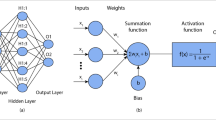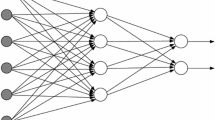Abstract
Industrial demand for models and simulation tools that can predict dimensional errors in manufacturing processes is vigorous. One example of these processes is ball-end finishing of inclined surfaces, which is a very complex task, due to the high number of variables that may influence dimensional errors during a cutting process and their different nature. This work firstly analyses the potential of semiempirical models to address the ball-end milling finishing, to conclude that these models are unable to process and to replicate the full range of milling strategies and slope combinations. Secondly, it goes on to analyse the possibilities of artificial neural networks as a means of overcoming this limitation. Two types of neural networks, multilayer perceptron (MLP) and radial basis functions (RBF), are tested. The results show that RBFs predict better than MLPs in all cases, achieving a precision of 1.83 μm in root mean squared error (RMSE) and a correlation coefficient of 0.897 with a 10 × 10 cross-validation scheme. Their training and tuning times are also 2.5 times shorter in all cases. Finally, the use of 3D figures, generated from the best RBF model, yields interesting industrial results in the field of process engineering.
Similar content being viewed by others
References
Benardos PG, Vosniakos GC (2003) Predicting surface roughness in machining: a review. Int J Mach Tools Manuf 43(8):833–844
Chandrasekaran M, Muralidhar M, Krishna C, Dixit U (2010) Application of soft computing techniques in machining performance prediction and optimization: a literature review. Int J Adv Manuf Technol 46(5):445–464
Correa M, Bielza C, Ramirez MDJ, Alique JR (2008) A Bayesian network model for surface roughness prediction in the machining process. Int J Syst Sci 39(12):1181–1192
Martellotti ME (1941) An analysis of the milling process. Trans ASME 63:667
Quintana G, Ribatallada J, Ciurana Q (2010) Surface roughness generation and material removal rate in ball-end milling operations. Mater Manuf Process 25(6):386–398
Arizmendi M, Fernández J, Gil A, Veiga F (2009) Effect of tool setting error on the topography of surfaces machined by peripheral milling. Int J Mach Tools Manuf 49(1):36–52
López de Lacalle LN, Lamikiz A, Sánchez JA, Arana JL (2002) Improving the surface finish in high speed milling of stamping dies. J Mater Process Technol 123(2):292–302
Quintana G, Bustillo A, Ciurana J (2012) Prediction, monitoring and control of surface roughness in high-torque milling machine operations. Int J Comput Integr Manuf 25(12):1129–1138
Beggan C, Woulfe M, Young P, Byrne G (1999) Using acoustic emission to predict surface quality. Int J Adv Manuf Technol 15(10):737–742
Vivancos J, Luis CJ, Ortiz JA, González HA (2005) Analysis of factors affecting the high-speed side milling of hardened die steels. J Mater Process Technol 162-163(SPEC. ISS):696–701
Díez-Pastor JF, Bustillo A, Quintana G, García-Osorio C (2012) Boosting projections to improve surface roughness prediction in high-torque milling operations. Soft Comput 16(8):1427–1437
Choudhury SK, Bartarya G (2003) Role of temperature and surface finish in predicting tool wear using neural network and design of experiments. Int J Mach Tools Manuf 43(7):747–753
Thangavel P, Selladurai V (2008) An experimental investigation on the effect of turning parameters on surface roughness. Int J Manuf Res 3(3):285–300
Ho W, Tsai J, Lin B, Chou J (2009) Adaptive network-based fuzzy inference system for prediction of surface roughness in end milling process using hybrid Taguchi-genetic learning algorithm. Expert Syst Appl 36(2 PART 2):3216–3222
Benardos PG, Vosniakos GC (2002) Prediction of surface roughness in CNC face milling using neural networks and Taguchi’s design of experiments. Robot Comput Integr Manuf 18(5-6):343–354
Brezocnik M, Kovacic M (2003) Integrated genetic programming and genetic algorithm approach to predict surface roughness. Mater Manuf Process 18(3):475–491
Ozel T, Karpat Y (2005) Predictive modeling of surface roughness and tool wear in hard turning using regression and neural networks. Int J Mach Tools Manuf 45(4-5):467–479
Bustillo A, Correa M (2012) Using artificial intelligence to predict surface roughness in deep drilling of steel components. J Intell Manuf 23(5):1893–1902
Dhokia VG, Kumar S, Vichare P, Newman ST (2008) An intelligent approach for the prediction of surface roughness in ball-end machining of polypropylene. Robot Comput Integr Manuf 24(6):835–842
Vapnik V (2000) The nature of statistical learning theory. Springer Science & Business Media
Drucker H, Burges CJ, Kaufman L, Smola A, Vapnik V (1997) Support vector regression machines. Adv Neural Inf Process Syst 9:155–161
Suykens JA, Vandewalle J (1999) Least squares support vector machine classifiers. Neural Process Lett 9(3):293–300
Lela B, Bajić D, Jozić S (2009) Regression analysis, support vector machines, and Bayesian neural network approaches to modeling surface roughness in face milling. Int J Adv Manuf Technol 42(11-12):1082–1088
Gan B, Huang YJ, Zheng GX (2010) Prediction of surface roughness profiles for milling process with fractal parameters based on LS-SVM. Adv Mater Res 97:1186–1193
Quintana G, Garcia-Romeu ML, Ciurana J (2011) Surface roughness monitoring application based on artificial neural networks for ball-end milling operations. J Intell Manuf 22(4):607–617
Grzenda M, Bustillo A (2013) The evolutionary development of roughness prediction models. Appl Soft Comput 13(5):2913–2922
Yıldız AR (2013) A new hybrid artificial bee colony algorithm for robust optimal design and manufacturing. Appl Soft Comput 13(5):2906–2912
Yıldız AR (2009) A novel particle swarm optimization approach for product design and manufacturing. Int J Adv Manuf Technol 40(5-6):617–628
El-Mounayri H, Dugla Z, Deng H (2003) Prediction of surface roughness in end milling using swarm intelligence. In Swarm Intelligence Symposium, SIS'03. Proceedings of the 2003 I.E. pp 220–227
Yıldız AR, Solanki KN (2012) Multi-objective optimization of vehicle crashworthiness using a new particle swarm based approach. Int J Adv Manuf Technol 59(1-4):367–376
Yang XS, Deb S (2009) Cuckoo search via Lévy flights. In nature & biologically inspired computing. NaBIC 2009. World Congress on, IEEE, pp 210–214
Yıldız AR (2013) Cuckoo search algorithm for the selection of optimal machining parameters in milling operations. Int J Adv Manuf Technol 64(1-4):55–61
Chiou JP, Wang FS (1999) Hybrid method of evolutionary algorithms for static and dynamic optimization problems with application to a fed-batch fermentation process. Comput Chem Eng 23(9):1277–1291
Yıldız AR, Ozturk F (2006) Hybrid enhanced genetic algorithm to select optimal machining parameters in turning operation. Proc Inst Mech Eng B J Eng Manuf 220(12):2041–2053
Öztürk N, Yıldız AR, Kaya N, Öztürk F (2006) Neuro-genetic design optimization framework to support the integrated robust design optimization process in CE. Concurr Eng 14(1):5–16
Yıldız AR (2012) A comparative study of population-based optimization algorithms for turning operations. Inf Sci 210:81–88
Bustillo A, Díez-Pastor JF, Quintana G, García-Osorio C (2011) Avoiding neural network fine tuning by using ensemble learning: application to ball-end milling operations. Int J Adv Manuf Technol 57(5-8):521–532
López de Lacalle LN, Lamikiz A, Sánchez JA, Salgado MA (2004) Effects of tool deflection in the high-speed milling of inclined surfaces. Int J Adv Manuf Technol 24:9–10
López de Lacalle LN, Lamikiz A, Sánchez JA, Salgado MA (2007) Toolpath selection based on the minimum deflection cutting forces in the programming of complex surfaces milling. Int J Mach Tools Manuf 47:388–400
Salgado M, López de Lacalle LN, Lamikiz A, Muñoa M, Sánchez JA (2005) Evaluation of the stiffness chain on the deflection of end-mills under cutting forces. Int J Mach Tools Manuf 45:727–739
Quiza R, Figueira L, Davim JP (2008) Comparing statistical models and artificial neural networks on predicting the tool wear in hard machining D2 AISI steel. Int J Adv Manuf Technol 37(7-8):641–648
Ezugwu EO, Arthur SJ, Hines EL (1995) Tool-wear prediction using artificial neural networks. J Mater Process Technol 49(3):255–264
Li X, Nee AYC (1996) Monitoring cutting conditions for tool scheduling in CNC machining. Manuf Syst 25(4):377–383
Srinivasa P, Nagabhushana TN, Rao PR (2002) Flank wear estimation in face milling based on radial basis function neural networks. Int J Adv Manuf Technol 20(4):241–247
Ezugwu EO, Fadare DA, Bonney J, Da Silva RB, Sales WF (2005) Modelling the correlation between cutting and process parameters in high-speed machining of Inconel 718 alloy using an artificial neural network. Int J Mach Tools Manuf 45(12):1375–1385
Rosenblatt F (1958) The perceptron: a probabilistic model for information storage and organization in the brain. Psychol Rev 65(6):386
Liu X, Bowyer KW, Hall LO (2004) Decision trees work better than feed-forward back-prop neural nets for a specific class of problems. In Systems, Man and Cybernetics, IEEE International Conference on 6:5969–5974
Hornik K, Stinchcombe M, White H (1989) Multilayer feedforward networks are universal approximators. Neural Netw 2(5):359–366
Yegnanarayana B (2009) Artificial neural networks. PHI Learning Pvt. Ltd.
Bloch G, Denoeux T (2003) Neural networks for process control and optimization: two industrial applications. ISA Trans 42(1):39–51
Cybenko G (1989) Approximation by superpositions of a sigmoidal function. Math Control Signals Syst 2(4):303–314
Broomhead DS, Lowe D (1988) Multivariable functional interpolation and adaptative networks. Complex Syst 2:321–355
Leonard JA, Kramer MA (1991) Radial basis function networks for classifying process faults. Control Syst IEEE 11(3):31–38
Hall M, Frank E, Holmes G, Pfahringer B, Reutemann P, Witten IH (2009) The WEKA data mining software: an update. ACM SIGKDD Explor Newsl 11(1):10–18
Cho S, Binsaeid S, Asfour S (2010) Design of multisensor fusion-based tool condition monitoring system in end milling. Int J Adv Manuf Technol 46(5-8):681–694
Bustillo A, Ukar E, Rodriguez JJ, Lamikiz A (2011) Modelling of process parameters in laser polishing of steel components using ensembles of regression trees. Int J Comput Integr Manuf 24(8):735–747
Arthur D, Vassilvitskii, S (2007) k-means++: The advantages of careful seeding. In proceedings of the eighteenth annual ACM-SIAM symposium on discrete algorithms, Society for Industrial and Applied Mathematics, pp 1027–1035
Cameron AC, Windmeijer FA (1997) An R-squared measure of goodness of fit for some common nonlinear regression models. J Econ 77(2):329–342
Kanungo DP, Sharma S, Pain A (2014) Artificial neural network (ANN) and regression tree (CART) applications for the indirect estimation of unsaturated soil shear strength parameters. Front Earth Sci 8(3):439–456
Author information
Authors and Affiliations
Corresponding author
Rights and permissions
About this article
Cite this article
Arnaiz-González, Á., Fernández-Valdivielso, A., Bustillo, A. et al. Using artificial neural networks for the prediction of dimensional error on inclined surfaces manufactured by ball-end milling. Int J Adv Manuf Technol 83, 847–859 (2016). https://doi.org/10.1007/s00170-015-7543-y
Received:
Accepted:
Published:
Issue Date:
DOI: https://doi.org/10.1007/s00170-015-7543-y




